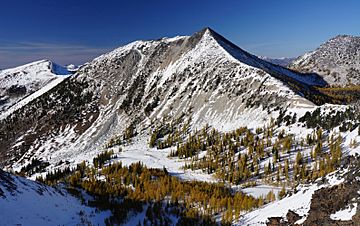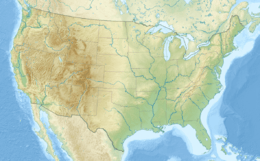Courtney Peak (Washington) facts for kids
Quick facts for kids Courtney Peak |
|
|---|---|

Courtney Peak, south aspect
|
|
| Highest point | |
| Elevation | 8,392 ft (2,558 m) |
| Prominence | 672 ft (205 m) |
| Geography | |
| Parent range | Methow Mountains North Cascades |
| Topo map | USGS Oval Peak |
| Climbing | |
| First ascent | Unknown |
| Easiest route | Southeast Ridge class 2 |
Courtney Peak is a mountain summit in Washington state. It stands at 8,392-foot (2,558-metre) tall. This peak is part of the Methow Mountains, which are a smaller group of mountains within the larger North Cascades range.
You can find Courtney Peak on Sawtooth Ridge. It is protected inside the Lake Chelan-Sawtooth Wilderness. This wilderness area is part of the Okanogan National Forest. Courtney Peak is one of the 100 highest peaks in Washington.
The mountain was named in 1985 to honor James (Ray) Courtney. He lived in Stehekin his whole life. Ray Courtney was a commercial packer. This means he helped guide people and their supplies through the mountains. The area around Courtney Peak was one of his favorite places to visit on these trips. Ray Courtney sadly passed away in an accident while leading one of his guided outings.
Water from the west side of the mountain flows into nearby Lake Chelan. Water from the north side goes into Oval Creek. Water from the east side flows into Buttermilk Creek. Both Oval and Buttermilk creeks are branches of the Twisp River.
Mountain Weather
Courtney Peak is located east of the main Cascade mountains. This means the weather here is a bit drier than areas to the west. Summers can be warm, and sometimes there are thunderstorms.
Most weather systems start over the Pacific Ocean. They travel northeast towards the Cascade Mountains. When these weather systems reach the tall peaks of the Cascades, they are forced to rise. This causes them to drop their moisture as rain or snow. This process is called Orographic lift.
Because of this, the North Cascades get a lot of rain and snow. Winter months bring the most snowfall. Courtney Peak is very tall, so it can have snow on its slopes in late spring and early fall. Winters on the mountain can be very cold.
How Mountains Are Formed
The North Cascades have very rugged land. You can see jagged peaks, long ridges, and deep valleys carved by glaciers. These different landforms and big changes in height happened over millions of years. They were created by powerful geological events. These events also led to different climates and types of plants in the area.
The Cascade Mountains started forming millions of years ago. This was during a time called the late Eocene Epoch. The North American Plate was slowly moving over the Pacific Plate. This movement caused volcanoes to erupt.
Also, small pieces of the Earth's crust, called terranes, came together. These pieces helped create the North Cascades about 50 million years ago.
Later, during the Pleistocene period, glaciers played a big role. This was over two million years ago. Huge sheets of ice moved across the land many times. They scraped away rock and left behind rocky debris. The "U"-shaped valleys you see today were carved out by these glaciers.
The main forces that created the tall peaks and deep valleys of the North Cascades are uplift and faulting. Uplift means the land was pushed upwards. Faulting means the Earth's crust cracked and moved. These forces, combined with the action of glaciers, shaped the mountains we see today.




